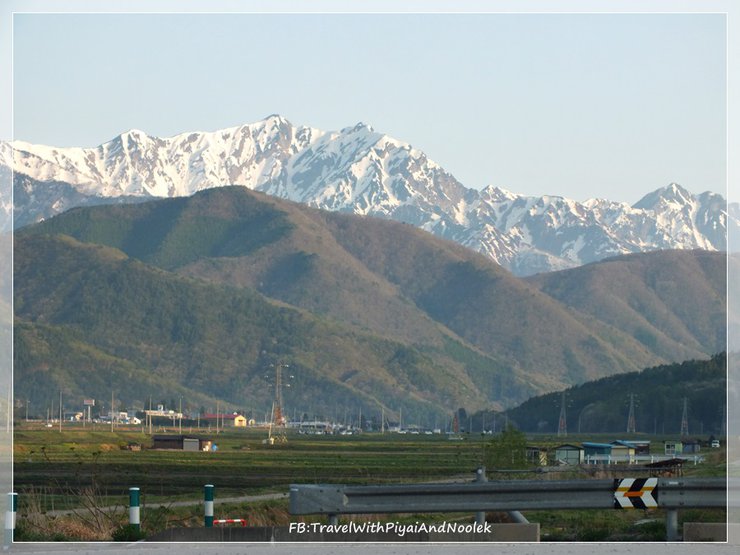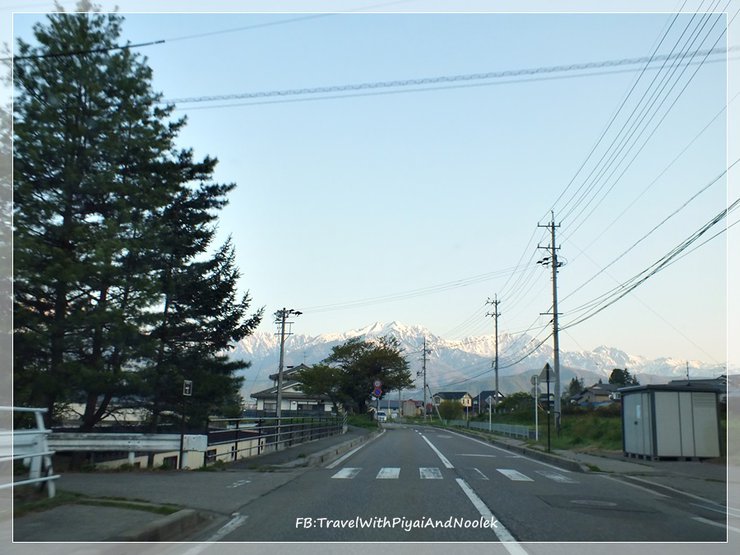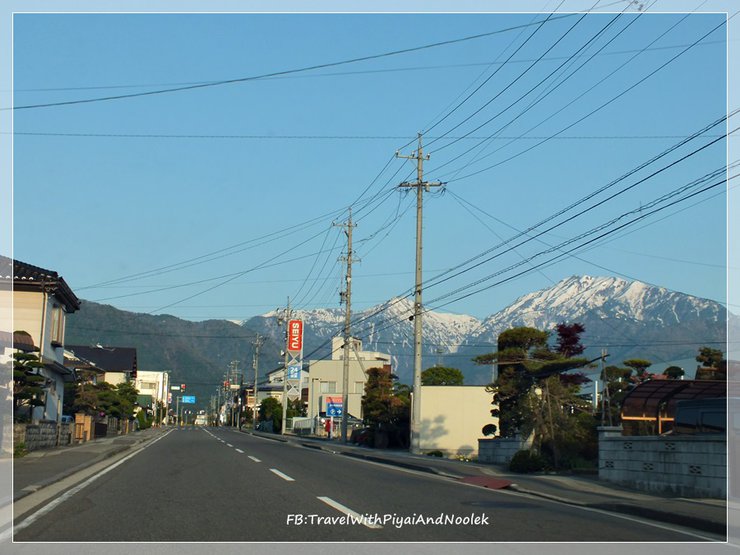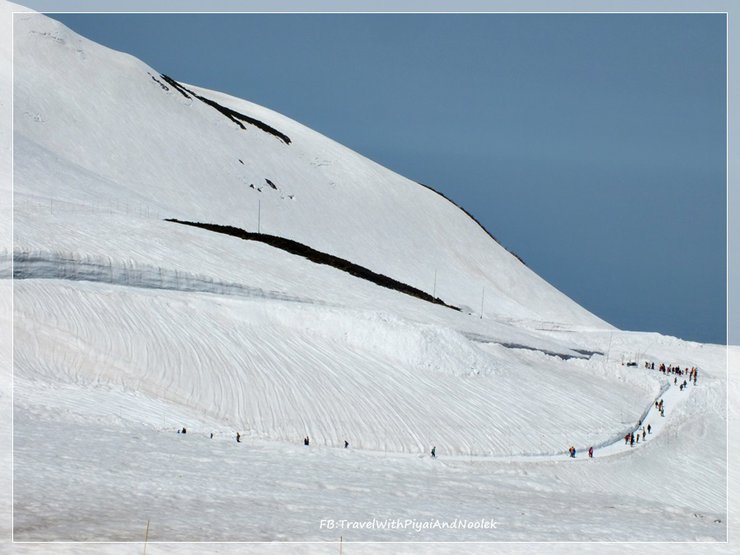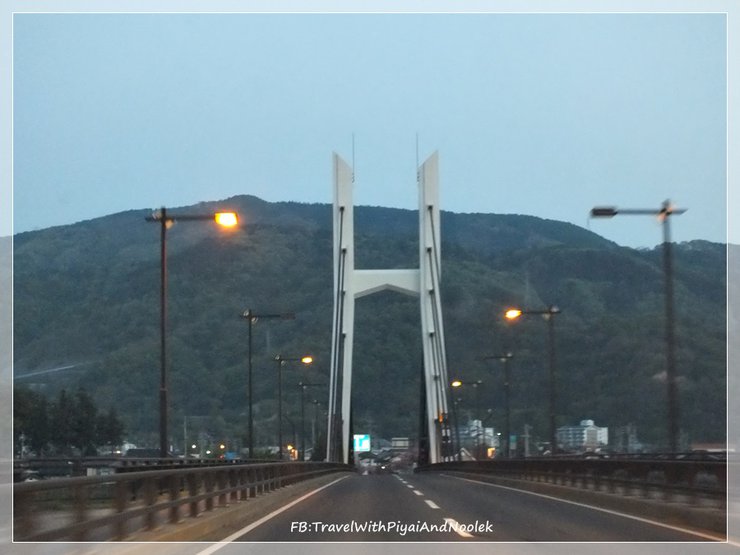
The highlight of our Japan Golden Week trip with my little sister and older brother is about to begin.
Today, we'll continue our journey from where we left off in the previous episode https://th.readme.me/p/4640.
The main reason why my little sister and I reluctantly decided to travel during the (so-called) off-season is our destination today.
The image of towering white snow walls has been a dream for many travelers, a place they long to visit at least once in their lifetime.
It's like a mystery, how something like this could even exist.
When we started researching this tourist route, we discovered that the highlights weren't limited to the Snow Wall.
The entire journey, stretching from Toyama to Nagano or vice versa, is filled with wonders.
Depending on which side you start from, the diverse natural landscape necessitates a variety of transportation methods throughout the trip.
This unique aspect is another reason why we're so eager to experience this place firsthand.
Last night before bed, we agreed to set off at 4 am sharp.
However, it's now 5 am, and our alarm failed to wake us up.
We have about an hour to reach our starting point, Ogizawa Station, for the Tateyama Kurobe Alpine Route, a journey through snow-covered valleys, dams, and natural gorges using various modes of transportation.
For more information, please visit https://www.alpen-route.com/th/
It only took the two of us 15 minutes to get downstairs, where our two companions were already waiting.
With no time to apologize, we quickly loaded our belongings into the car and set off.
We'll have plenty of time to confess our sins on the road in the days to come.

From Chikuma to Ogizawa Station

Running through the forest

Run through the mountain

Through the mountains, there is
After our car had been running through the mountains for about an hour,
The scenery in front of the car window began to change.

The long, snow-white mountain range lifted our spirits.

The goal is not far away.

The greatness that awaits


Approaching Ogizawa Station

The closer we drove to our destination, the more we felt surrounded by nature.

We arrived at the parking lot around nine o'clock, as expected, we were among the latecomers.
Because the parking lot was full of tourist cars. Luckily, we were lucky to have 2-3 more cars left nearby.
Everyone dispersed to prepare their belongings, camera equipment ready, everyone was ready for an adventure on the Japan Alps route.

The eldest brother walked quickly ahead.

Cars are still coming in one after another.


Walk in the direction he laid out for you to walk.

We're here. Let's go buy our travel tickets.
Travel tickets can be purchased as round-trip tickets, which will be discounted. And you must keep it well because you will need to use it throughout your journey.

Station Building

A map showing the elevation of each point, the travel time to the destination, and the mode of transportation for each segment.

The price tag clearly states whether it is a single trip or a round trip, so you can choose according to your preference.

We chose a round-trip ticket between Ogizawa Station and Murodo for 9,050 yen.
From Ogizawa Station, we have to take an electric bus through the tunnel (Kanden Tunnel)
To our first destination, Kurobe Dam.
The dam was built due to the high demand for electricity after World War II.

With a ticket in hand, you can enter the site.
This route is open to tourists from mid-April to November each year.
However, the main highlight, the "Snow Wall", can only be seen for a short period of time.
That is, from mid-April to the end of May.
The snow will start to melt, and the height of the wall will gradually decrease until it disappears.
Therefore, it is mandatory to come during this period when the wall is still high.
This is one of the reasons why tourists flock to the site.
After waiting for a while, all tourists were released from the waiting area and allowed to board the electric bus (Trolley Bus).
This bus is powered by electricity and runs through the Kanden Tunnel, which has been in operation since the construction and transportation of materials needed for the construction of the Kurobe Dam. It runs between Ogizawa Station and Kurobe Dam, a distance of 6.1 kilometers.
The journey through the tunnel takes about 16 minutes, and the difference in elevation between the stations is 37 meters.

We have begun our journey.

Inside the tunnel

We have arrived at Kurobe Dam

Let's go!
When you get off the bus, tourists will encounter a steep staircase that will take us to the viewpoint (Kurobe Resthouse)
At an altitude of 1,508 meters

This is the first test of the journey.

Along the way, there is a natural spring where people can stop to drink water. The Japanese believe that this water is sacred and can prevent illness.

We have reached the exit.

The top floor is a spacious balcony with panoramic views.

The majority of the mountain range remains covered in snow, having recently emerged from a harsh winter.
The Kurobe Dam is the tallest concrete arch dam in Japan.
It spans the curved water surface of Lake Kurobe.
Standing at 186 meters tall, it was constructed during World War II.
This period marked a time of rapid economic development and national reconstruction for Japan, leading to a surge in electricity demand. The dam project was born out of this need, but its construction was fraught with challenges.
One of the most significant hurdles was the excavation of tunnels for the electric trolleybuses that traverse the valley. The constant presence of groundwater and sand posed a major obstacle.
The construction took seven years, employed 10 million workers (with 171 tragically losing their lives during the process), and was finally completed in 1963. The dam now provides electricity to the Kansai region.
It has also become a major tourist attraction along the Tateyama Kurobe Alpine Route.
From late June to mid-October, the dam releases water daily, creating a breathtaking spectacle.

High-angle view


A refreshing atmosphere, easy on the eyes
After admiring the scenic view from this viewpoint to our satisfaction,
We had to climb down the stairs to the dam crest area to continue to the next vehicle.


Slowly climb down the stairs


Dam crest

The water in the dam is calm and still.

The center point of the dam

Our goal is a small channel at the end of the road.
When I walked in, I was impressed.

A true reflection of the Thai-Japanese relationship

Queue to board the cable car (Cable Car) to climb up to the area called Kurobedaira
Kurobe Station cable car station is the only underground cable car station in Japan at an altitude of 1,455 meters.
To avoid being affected by heavy snowfall in winter
Runs in a tunnel between Kurobeko Station (near Kurobe Dam) and Kurobedaira Station
It takes about 5 minutes, a distance of 800 meters. They will divide the queue into two types: for general tourists and those who come in groups.
While waiting, they will distribute yellow cards with numbers on them. Before distributing, the officer will shout an explanation loudly.
But I'm sorry, it's in Japanese.
We guess it's the number of the ropeway that each tourist will use at the next station.
To manage the number of tourists

This is what the card looks like. Please keep it safe.

When the cable car arrives, the staff will allow the tourists who got off the cable car to disembark first.
Then, the group waiting to board will gradually walk up, with tourists
Everyone must pick up their original ticket for the staff to check again.
It can be seen that the ticket is very meaningful and important. It cannot be lost and must be kept with you at all times.
And it can be easily picked up and used.
Taking the cable car to the next station, which is fun and recommended by Mouse Lek, is to be at the front, next to the glass.
Because it will make us excited to go through the 800-meter tunnel.
In terms of safety, it is almost 100%.
It is an exciting experience that is hard to find in one's life.

Let's go!
The best view in the tunnel is in the middle section where there are short sections of split tracks
allowing two cable cars to pass each other within the tunnel as it climbs 373 meters in elevation.

So fast that I couldn't take a picture.

Upon arrival at Kurobedaira Station, there are souvenir shops, dessert shops, and ice cream parlors.
There is also an exit to enjoy the scenic view outside, which Nulek, P'Big, and the members did not miss this opportunity.
Because this station is located at an altitude of 1,828 meters above sea level.

A vast expanse of white snow as far as the eye can see.



Sunglasses are essential for visiting this place.
Because the snowflakes reflect sunlight, it can be very dazzling.
Although we can go for a walk,
Don't forget to check if the number of the ropeway we got is displayed on the computer screen.
So we can hurry up and queue up to wait for the Ropeway according to the number they specified.
After walking around for a while, the computer screen at the entrance shows the queue number
According to the yellow queue card obtained from the previous station.
It's time to take the cable car (Ropeway) from Kurobedaira Station to the next station, Daikanbo Station.
After checking the queue card at the first checkpoint with the ticket, they will let us into the inner area
To wait for the Tateyama Ropeway,
Which takes people from Daikanbo down to this station. Wait until the cable car stops completely.
Tourists who are going down get off the cable car and leave the area.
Then they will open the door of the cable car for us to get on. This cable car can carry a considerable number of tourists.
When the number of people reaches the limit, the door will close and the journey between stations will begin.

View of OMO from the Ropeway

The Tateyama Ropeway stretches 1.7 kilometers, carrying us up another 488 meters in elevation.
It is a cable car route with no supporting towers between the upper and lower stations, used to cross a deep chasm between the stations.
At an altitude of 2,316 meters, this means that the cable car's rope from the starting point to the end point without any intermediate supporting towers
is 1,700 meters long, making it the longest cable car route in Japan. The absence of supporting towers
makes the scenery along the way on this cable car indescribably beautiful. If the cable car were not full of people,
it would probably be possible to see a full 360 degrees around.

The journey this time took only 7 minutes, 7 minutes that I didn't want to end.
Especially when I learned that the construction of this gondola did not have any intermediate sling poles.
It made me wonder how much emphasis must have been placed on safety during construction.

We are nearing our destination.

Arrived at Daikanbo Station

Teeming with tourists
Upon arrival at Daikanbo Station, tourists have the option to stop and admire the scenic views from the station's observation deck first,
or continue their journey to the main highlight of the trip,
which is the highest point of the Tateyama Kurobe Alpine Route,
at an altitude of 2,450 meters, which will take another 10 minutes.
Mouse and Big Brother chose to continue immediately,
as we wanted to rush to see the grandeur and wonder that awaited us in the next few minutes.
Those who wish to continue their journey simply need to look for the sign that indicates the way to board the electric bus to Daikanbo Station.

Continue, follow this sign.
But if you want to stop and enjoy the view, follow the sign that says View Point and there will be a path to walk up the stairs to the viewpoint.
We thought we'd save it for the way down because we'll be coming back this way anyway.

Souvenir and boxed lunch shops inside the station
Traveling from Daikanbo Station to Murodo Station
The highest point of the Tateyama Mountains is an electric bus through a tunnel
At an altitude of 2,450 meters, this bus will run through a tunnel that is cold to the heart

On the Electric Train to Murodo
Despite the biting cold outside, we felt nothing inside the train. The train is powered by electricity,
making it smoke-free and environmentally friendly. The journey takes 10 minutes to cover 3.7 kilometers,
with an elevation difference of 134 meters between stations. In the middle of the tunnel, the electric buses
pass each other, creating a unique and stylish atmosphere.

We have arrived at our destination.
Murodo Station is the highest railway station in Japan.
It is the destination of this journey, where tourists can enjoy
scenic views and breathtaking beauty in every season.
It is also home to the Raicho (Ptarmigan), a bird that
lives only in mountainous areas and was once considered a "messenger of the gods".
With only about 200 remaining, it is a rare sight to behold.
The symbol of this station is the Raicho.

Everyone quickly gets off the bus, no time to wait.
Upon arrival at Murodo Station, we will find that it is teeming with tourists.
We simply follow the signs to exit the building, which will lead us to the main highlight we have been eagerly awaiting.

Follow this sign to exit the building.
As soon as you exit the station building, they will arrange a walkway for us to walk for safety and order.
Because in this area there will still be cars carrying tourists who come up from Toyama to park at this station.
Therefore, we must strictly follow the rope line that they have set up.
However, they have arranged for staff to take care of tourists at various points as well.

This is the first sign I've seen.

Tourists must follow the designated path.
Walk a little further and you will find the area for little adventurers on the snow path.
This area is a snow playground.

Children can enjoy the experience of snowboarding and skiing with the supervision of qualified staff.

The little tourists had a lot of fun.

Many adults, including me, could only watch with wide eyes,
wishing they could have a unique and memorable experience on this mountaintop like them.
We then followed the other tourists along the path they had created.

The image that appeared before me was nothing but white, and it was a breathtaking white.
So I scanned my eyes as wide as this pair of eyes could.
As if to memorize the image in front of me in its entirety, not forgetting even a single fragment.

The path that Noomlek and P'Yai are walking on is the ultimate aspiration
and the heart of the journey to this snowy path.
Because it is a walk amidst the snow walls (Snow Wall or Snow Corridor), which in Japanese is called Yuki No Otani

There is also a One Man Show Trekking.
Tateyama is a mountain with the highest snowfall in the world, with an average snow depth of 7 meters.
And it can reach 20 meters (as high as a 10-story building) in years with heavy snowfall.
Travelers can walk through a snow wall that is almost half a kilometer long.
After the opening of the route in April of each year, which usually starts at the end of April, the mountain will be announced year by year.
The exact time can be checked according to the announcement from the official website.
The period when the snow wall is at its highest is from the opening of the route in April to May.
When June arrives, the snow will gradually melt and the height will decrease.
The most amazing thing in my opinion is the idea of building a snow wall.
To use it as a selling point for tourism in Japan.
Because the snow wall is not something that occurs naturally.
But because the Japanese have surveyed and found that this area is the point with the highest average snow cover in the country.
So they use machines to blow the snow that falls on the ground to the side and use machines to compact the snow tightly.
To make it like a wall on both sides, resulting in an ice wall that is 10 meters high for tourists to come and see.
Not only from the brain, but also combined with pure skill that is difficult for any other nation to imitate.
After walking a short distance, there is a fork on the right hand side with a sign saying that this way is to Panorama.
As for walking straight ahead, it is to the snow wall.
My brother and I decided that we would go to see the panoramic view first.
So we followed the other people who had turned earlier.

The fork to Panorama Road

Pure white Omo is the best.

Walking on thick snow like this is not easy.

On the Panorama Trail, ropes will be set up to prevent us from walking outside the designated path.
Tourists can see the Tateyama Mountains all along the way.


Walking on the ice-covered snow can be challenging, as we have to be careful not to slip and fall.
Otherwise, we might end up with wet bottoms and bruised tails. However, some tourists take this opportunity to lie down and roll around for photos.
Or they strike various poses, as the chance to do something so strange like this doesn't come often.

Every angle is white like this

Walk back to the snow wall.
In the middle section, there will be a point where they say the snow wall is the highest today. Go check it out.
On the way back, there will be buses coming up from Toyama at intervals.
When a bus comes, tourists will raise their cameras to take記念照片.

Compared to the bus, the wall is very high.

And it keeps getting higher and higher.

See the world from an ant's perspective.


Little Mouse followed the other tourists to the point where a sign said, "This is the point where the snow wall is the highest."

Today, the water level is 15 meters, or about the height of a 4-story building. This is a decrease from the opening day, when the water level was as high as 18 meters.

Tourists lined up to take photos with the symbolic sign that they had made as evidence, which was a lot of fun.

Upon closer inspection, it becomes clear that the snow wall has been tightly packed.
Even with the strong sunshine, it is difficult to break down easily.
Nulek could only stand and look up with her neck stretched, amazed by the ingenuity of the Japanese.
In this area, there are banners for tourists to see the origin of the snow wall where we are walking.
It's a pity that Japan is still very nationalistic, so there is usually only information in Japanese.
Therefore, we can only look at the pictures and do not get the detailed information written in the explanation.
But from the pictures that appear, it seems that it is not easy to achieve such magnificent beauty.

The officers who have to brave the extreme cold to work on the mountaintop
Working in the midst of heavy snowfall like this is definitely not easy.
Also, if you think about the transportation system throughout the journey,
From the start of the journey up, we have to dig tunnels to travel through the cold and high mountains.
The ticket price we have to pay seems to be too cheap.
They also have signs showing the increasing thickness of the snow each day, made with colored cloth tied with string.

Nearby, there are signs that make Thai tourists like us happy.
Because they have made welcome signs in Thai, clearly along with other languages.

This shows that Thai tourists are also regulars who visit the mountain frequently.

After walking among the snow walls to our satisfaction, we walked back into the station building.

The officers' vehicles are still ready to operate throughout the tourist season.
From inside the station building, there will be an exit to the viewpoint where you can look down to the area below where we were walking just now.





This area also has a sign indicating the elevation of this station, which is 2,450 meters above sea level.
It is a popular spot for tourists to take記念照片.

The other side is a walkway for those who want to go skiing or trekking.


If you walk in the other direction, there is a fork in the road that leads to an area where you can carve messages on a small snow wall.
Tourists can carve messages and prayers on this snow wall.


Some tourists prefer to take photos here rather than at the large snow wall outside.
Because there is no sun here, there are fewer people, and you can take photos in all sorts of poses.
And the snow on the ground is white and not a road surface for cars to drive on like outside.
When you take a photo, it will look more beautiful.
However, it is quite difficult for those who want to leave a message on the snow wall.
Without any equipment, because the snow wall has been compacted into ice, it is very hard.
If you just use your bare hands to write on it like on sand, you won't be able to do it.

See skiers and trekking lib.


Tateyama Nature Conservation Center
Exhibits flora and fauna found in this area

All I could see were tourists dressed like this everywhere.
But for us, we could only walk on the white snow and slide around for fun.
Throwing snow at each other like we used to see kids do. Trying to do something like this to turn back time was fun.
Since Nulek and her friends bought round-trip tickets with the final destination being Murodo, we had to go back the same way.
On the way back, we just retraced our steps from the way we came.
We just wanted to spend a little more time at the viewpoint at Daikanbo Station, which we had missed.
When we arrived at Daikanbo Station, we followed the View Point sign and went up the stairs.
It will lead us to the viewpoint. When we went outside, this is what we saw.




I happened to see the moment when the gondolas passed each other.
After enjoying the magnificent view to our satisfaction, it was time for us to continue our journey down to the next station.
And here is the view from the Tateyama gondola.


If possible, try to stand close to the glass so you can see the scenery like this.


As soon as we arrived at Kurobedaira Station, a cable car came along before we could even take a walk, so we got on it.

As usual, I chose to sit close to the front window to capture the atmosphere of the vertical journey inside the tunnel.

Ready to go
The 50-minute journey that seemed long, but when traveling with excitement
It seems like the distance from the station is so close that I regret the time

As the cable car approached the station,
Tourists waiting to board the next round took pictures in the same way that Noomlek did on the way up.

Acting like we're celebrities, as soon as the car pulled up, there were flashes of light everywhere.

The next round is coming up.
After getting off the cable car, we had to walk back to the dam crest like we did on the way up, to get back on the electric bus at the Kurobe Dam Station.




Let's line up to wait for the bus to Ogizawa Station.

It only took fifteen minutes to reach our destination, Ogizawa Station, where we had parked our car that morning.


The ticket booth area was deserted, and the tourist buses that were packed this morning were gradually thinning out.
They must have gradually returned before us, but it is also possible that some of them may have stayed overnight on the mountain.
Because near Murodo Station, there is the Tateyama Hotel, which is located near the station to accommodate tourists who want to stay overnight and go skiing.

We drove out to our accommodation for the night in Matsumoto.


A view from the window that still allows you to see the Tateyama mountain range

Lush green views as we enter Matsumoto
And then we arrived at our destination, the Montagne Matsumoto Hotel that we had booked.
http://www.hotel-montagne.com/
It is considered an affordable accommodation and has the advantage of being right next to the train station.
Backpackers who are planning to visit this city will find it very convenient, as it is only a 5-minute walk away.

Interior

And this is the view from the window of the room.

We have a plan to visit Matsumoto Castle tomorrow, a famous castle that should not be missed at all.
Don't forget to join us for more trips.
You can say hello to us at
https://www.facebook.com/TravelWithPiyaiAndNoolek/
Piyai&Noolek
Friday, September 27, 2024 10:20 AM



